Abstract
Background
The Silva system is a pattern-based classification system that stratifies endocervical adenocarcinomas (AC) into 3 categories to assess the risk of lymph node (LN) metastasis. This study aimed to evaluate whether this novel risk stratification system is applicable to all endocervical AC, including usual and variant, and to suggest a suitable management plan for cervical AC.
Methods
We retrospectively retrieved consecutive pathology cases with a final diagnosis of endocervical AC treated via radical hysterectomy and pelvic lymphadenectomy. Specimens were classified by consensus according to the Silva system based on “pattern of invasion” as A, B, or C, further clinical/pathologic features were assessed according to pattern-based classification.
Results
A total of 76 cases of invasive cervical AC were evaluated. Of these, 63 (82.9%) were categorized as usual-type endocervical AC and 13 (17.1%) as special types. Among those with usual and variants, all patients with pattern A tumor had no LN metastasis and did not develop recurrence. Likewise, multivariate analysis revealed that LN metastasis and pattern C or B tumors are significant independent predictors of disease-free survival (DFS). Although pattern A tumors had no LN metastasis, they also developed complications after surgery, similar to pattern B or C tumors.
Conclusion
Regardless of histologic subtypes, pattern A tumors had no LN metastasis and no recurrence. Thus, the Silva classification system can influence the clinical management of all types of endocervical AC. Conservative management is reasonable in all patients with endocervical AC with pattern A tumors.



Similar content being viewed by others
References
Fujiwara H, Yokota H, Monk B, et al (2014) Gynecologic Cancer InterGroup (GCIG) consensus review for cervical adenocarcinoma. Int J Gynecol Cancer 24(9 Suppl 3):S96–101. https://doi.org/10.1097/igc.0000000000000263
Rodriguez-Carunchio L, Soveral I, Steenbergen RD, et al (2015) HPV-negative carcinoma of the uterine cervix: a distinct type of cervical cancer with poor prognosis. BJOG 122(1):119–127. https://doi.org/10.1111/1471-0528.13071
Fujiwara K, Monk B, Devouassoux-Shisheboran M (2014) Adenocarcinoma of the uterine cervix: why is it different? Curr Oncol Rep 16(12):416. https://doi.org/10.1007/s11912-014-0416-y
Network NCC (2018) Clinical Practice Guidelines in Oncology (NCCN guidelines). Version 2. 2018; cited 26 June 2018. https://www.NCCN.org.,
Landoni F, Maneo A, Colombo A, et al (1997) Randomised study of radical surgery versus radiotherapy for stage Ib-IIa cervical cancer. Lancet (London, England) 350(9077):535–540. https://doi.org/10.1016/s0140-6736(97)02250-2
Comparison of risk factors for invasive squamous cell carcinoma and adenocarcinoma of the cervix: collaborative reanalysis of individual data on 8,097 women with squamous cell carcinoma and 1,374 women with adenocarcinoma from 12 epidemiological studies (2007). Int J Cancer 120 (4):885–891. doi:10.1002/ijc.22357
Wang SS, Sherman ME, Hildesheim A, et al (2004) Cervical adenocarcinoma and squamous cell carcinoma incidence trends among white women and black women in the United States for 1976–2000. Cancer 100(5):1035–1044. https://doi.org/10.1002/cncr.20064
Mehra G, Weekes A, Vantrappen P, et al (2010) Laparoscopic assisted radical vaginal hysterectomy for cervical carcinoma: morbidity and long-term follow-up. Eur J Surg Oncol 36(3):304–308. https://doi.org/10.1016/j.ejso.2009.08.009
Baalbergen A, Ewing-Graham PC, Hop WC, et al (2004) Prognostic factors in adenocarcinoma of the uterine cervix. Gynecol Oncol 92(1):262–267
Diaz De Vivar A, Roma AA, et al (2013) Invasive endocervical adenocarcinoma: proposal for a new pattern-based classification system with significant clinical implications: a multi-institutional study. Int J Gynecol Pathol 32(6):592–601. https://doi.org/10.1097/PGP.0b013e31829952c6
Roma AA, Mistretta TA, Diaz De Vivar A, et al (2016) New pattern-based personalized risk stratification system for endocervical adenocarcinoma with important clinical implications and surgical outcome. Gynecol Oncol 141(1):36–42. https://doi.org/10.1016/j.ygyno.2016.02.028
Kojima A, Mikami Y, Sudo T, et al (2007) Gastric morphology and immunophenotype predict poor outcome in mucinous adenocarcinoma of the uterine cervix. Am J Surg Pathol 31(5):664–672. https://doi.org/10.1097/01.pas.0000213434.91868.b0
Karamurzin YS, Kiyokawa T, Parkash V, et al (2015) Gastric-type endocervical adenocarcinoma: an aggressive tumor with unusual metastatic patterns and poor prognosis. Am J Surg Pathol 39(11):1449–1457. https://doi.org/10.1097/pas.0000000000000532
Smith HO, Tiffany MF, Qualls CR, et al (2000) The rising incidence of adenocarcinoma relative to squamous cell carcinoma of the uterine cervix in the United States–a 24-year population-based study. Gynecol Oncol 78(2):97–105. https://doi.org/10.1006/gyno.2000.5826
Roma AA, Diaz De Vivar A, Park KJ, et al (2015) Invasive endocervical adenocarcinoma: a new pattern-based classification system with important clinical significance. Am J Surg Pathol 39(5):667–672. https://doi.org/10.1097/pas.0000000000000402
Rutgers JK, Roma AA, Park KJ, et al (2016) Pattern classification of endocervical adenocarcinoma: reproducibility and review of criteria. Modern Pathol 29(9):1083–1094. https://doi.org/10.1038/modpathol.2016.94
Paquette C, Jeffus SK, Quick CM, et al (2015) Interobserver variability in the application of a proposed histologic subclassification of endocervical adenocarcinoma. Am J Surg Pathol 39(1):93–100. https://doi.org/10.1097/pas.0000000000000316
Smith JS, Lindsay L, Hoots B, et al (2007) Human papillomavirus type distribution in invasive cervical cancer and high-grade cervical lesions: a meta-analysis update. Int J Cancer 121(3):621–632. https://doi.org/10.1002/ijc.22527
Douglas G, Howitt BE, Schoolmeester JK, et al (2017) Architectural overlap between benign endocervix and pattern-A endocervical adenocarcinoma: Are all pattern-A tumors invasive? Pathol Res Pract 213(7):799–803. https://doi.org/10.1016/j.prp.2017.03.008
Alvarado-Cabrero I, Roma AA, Park KJ, et al (2017) Factors predicting pelvic lymph node metastasis, relapse, and disease outcome in pattern C Endocervical adenocarcinomas. Int J Gynecol Pathol 36(5):476–485. https://doi.org/10.1097/pgp.0000000000000357
Cibula D, Oonk MH, Abu-Rustum NR (2015) Sentinel lymph node biopsy in the management of gynecologic cancer. Curr Opin Obstetr Gynecol 27(1):66–72. https://doi.org/10.1097/gco.0000000000000133
Kinney WK, Hodge DO, Egorshin EV, et al (1995) Identification of a low-risk subset of patients with stage IB invasive squamous cancer of the cervix possibly suited to less radical surgical treatment. Gynecol Oncol 57(1):3–6. https://doi.org/10.1006/gyno.1995.1091
Covens A, Rosen B, Murphy J,et al (2002) How important is removal of the parametrium at surgery for carcinoma of the cervix? Gynecol Oncol 84(1):145–149. https://doi.org/10.1006/gyno.2001.6493
Acknowledgements
This work was supported by 2017 Inje University Busan Paik Hospital research Grant.
Author information
Authors and Affiliations
Corresponding authors
Ethics declarations
Conflict of interest
The authors have declared no conflicts of interest.
Additional information
Publisher’s Note
Springer Nature remains neutral with regard to jurisdictional claims in published maps and institutional affiliations.
About this article
Cite this article
Byun, J.M., Cho, H.J., Park, H.Y. et al. Clinical significance of the pattern-based classification in endocervical adenocarcinoma, usual and variants. Int J Clin Oncol 24, 1264–1272 (2019). https://doi.org/10.1007/s10147-019-01472-4
Received:
Accepted:
Published:
Issue Date:
DOI: https://doi.org/10.1007/s10147-019-01472-4




